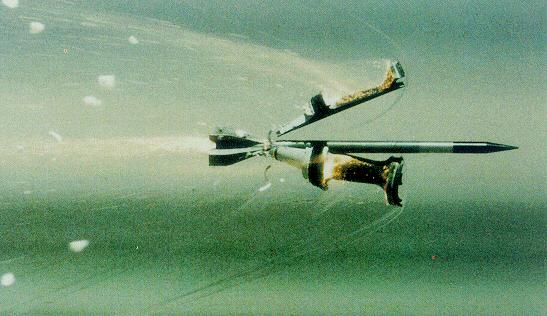
|
|
SUBSIM: The Web's #1 resource for all submarine & naval simulations since 1997
 |
SUBSIM: The Web's #1 resource for all submarine & naval simulations since 1997 |
|
|
 12-11-10, 02:11 AM
12-11-10, 02:11 AM
|
#1 | |
|
Ocean Warrior
 Join Date: Aug 2007
Location: Montreal, Canada
Posts: 2,983
Downloads: 102
Uploads: 1
|
For kinetic AT rounds, aren't the majority of them made of either depleted uranium or tungsten? (ie: Denser metals?)
__________________
Quote:

|
|

|

|
 12-11-10, 02:37 AM
12-11-10, 02:37 AM
|
#2 | |
|
Lucky Sailor
Join Date: Oct 2010
Location: Rome
Posts: 4,273
Downloads: 81
Uploads: 0
|
Quote:
Yes, they work by having a dense core, with a larger "case" around it (I don't know the technical term). The case allows the Sabot round to be loaded into much larger bore guns than the core.  The case, as you can see, breaks away in flight, and the core flies just like a dart would. Upon impact with an armored target, it bores through the armor via the kinetic energy, but that process "plasmafies" the core. So now this super heated uranium plasma is bouncing around inside the target, incinerating anything it touches. I think they work best on armored targets, as they need that process to be effective. They'd simply pass through light targets, like cars and airplanes. Now imagine this same round, coming out of a naval gun with MORE kinetic energy than those huge 14" and 16" ships used to carry. Since this is (I assume) a strictly Line of sight round, I'd imagine they'd use this type of round in Surface to Surface warfare, as it makes a very small hole, but huge damage inside. |
|

|

|
 12-11-10, 04:25 AM
12-11-10, 04:25 AM
|
#3 |
|
Navy Seal
 |
^^ A very large and horrifying flechette.
 The case that breaks away is the sabot. The example in your photo there is APFSDS - Armor Piercing, Fin Stabilized, Discarding Sabot. |

|

|
 |
| Thread Tools | |
| Display Modes | |
|
|
